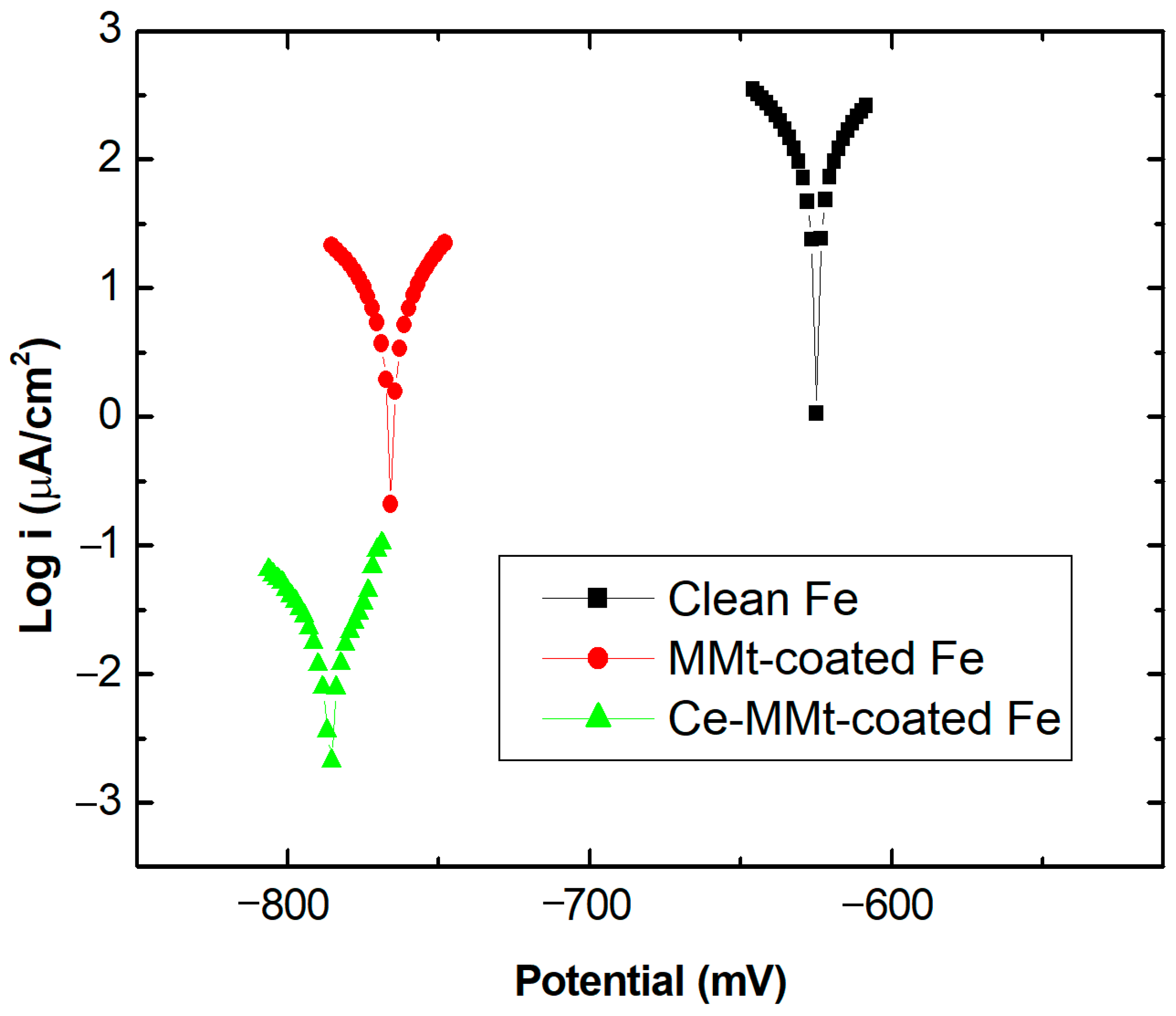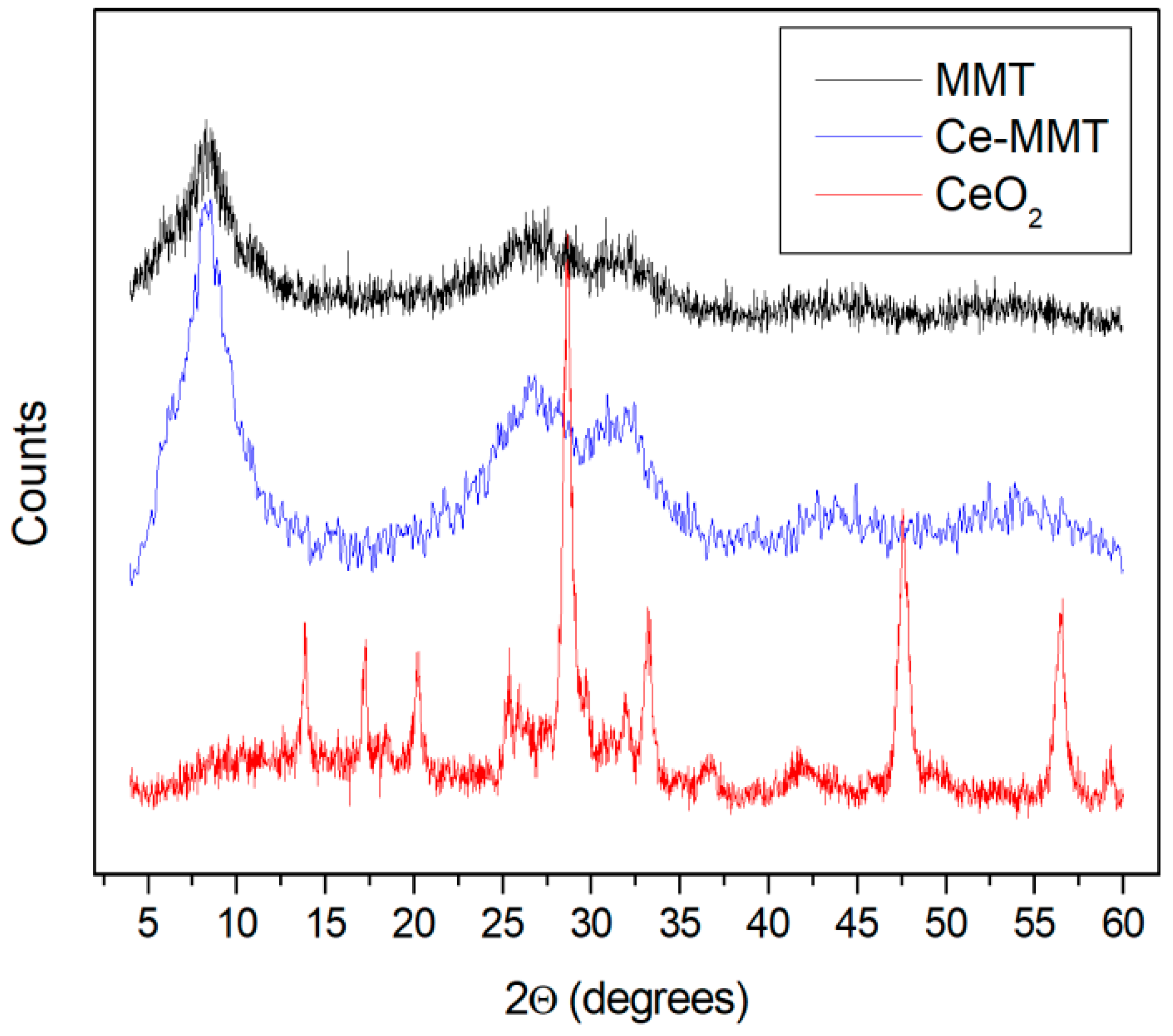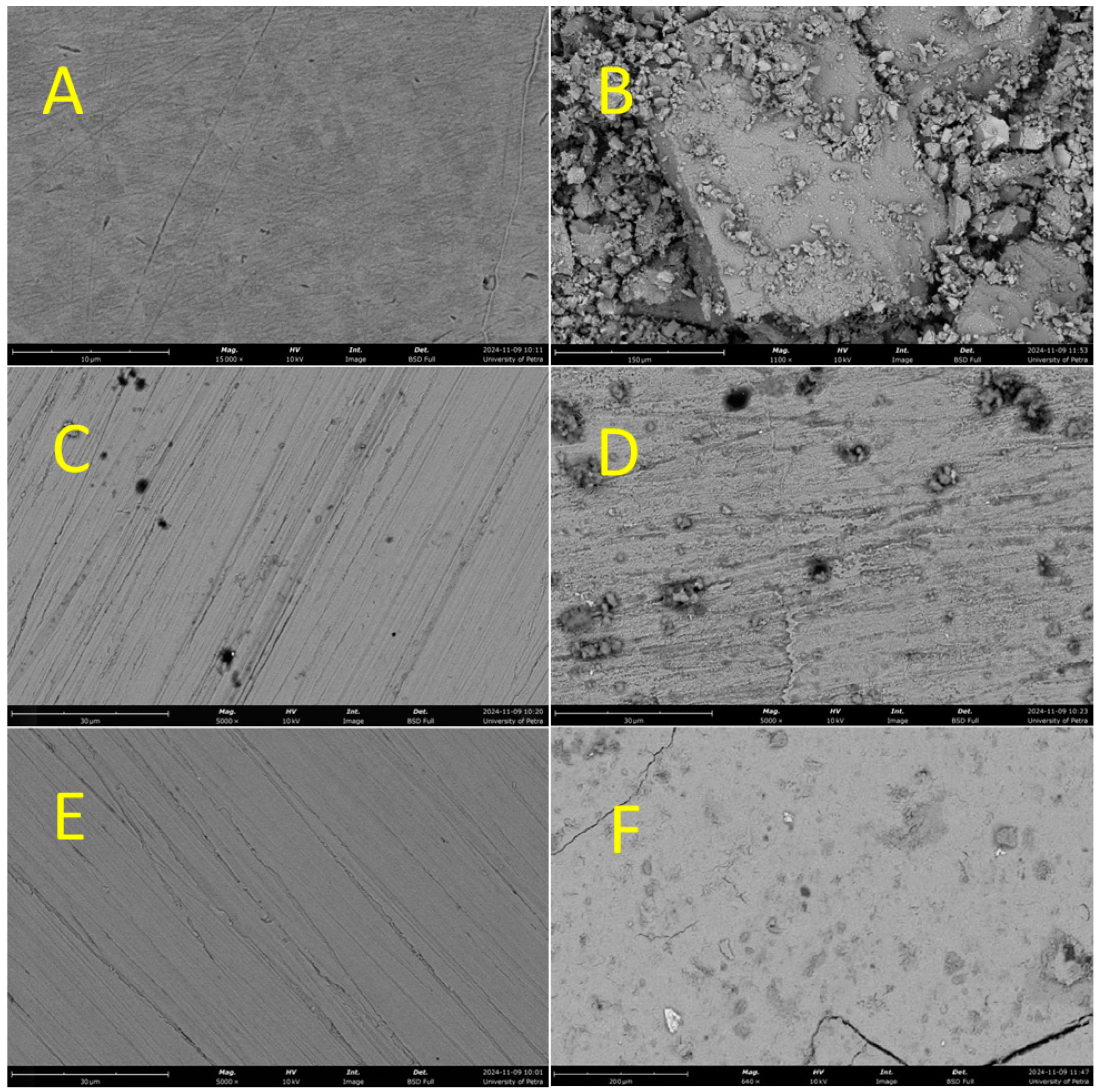The Effect of CeO2 Doping on the Prevention of the Corrosion of Montmorillonite on Mild Steel in Hydrochloric Acid Solution
Abstract
1. Introduction
2. Materials and Methods
2.1. Materials
2.2. NCM Coating Preparation
2.3. Weight Loss Measurements
2.4. Electrochemical Measurements
2.5. XRD Measurements
2.6. SEM Investigation
3. Results and Discussion
3.1. Weight Loss Study
3.2. XRD Analysis
3.3. SEM Study
4. Conclusions
Funding
Institutional Review Board Statement
Informed Consent Statement
Data Availability Statement
Acknowledgments
Conflicts of Interest
References
- Ansari, A.; Youssefi, Y.; Tanghourte, M.; Ouassou, N.; Asoufar, N.; Znini, M.; Lgaz, H.; Mabrouk, E.H.; Azrour, M.; Lee, H.-S.; et al. Assessment of Warionia saharea Essential Oil as a Green Corrosion Inhibitor for Mild Steel in HCl: Experimental and Computational Studies. Coatings 2024, 14, 1164. [Google Scholar] [CrossRef]
- Al-Mayouf, A.M.; Al-Shalwi, M.N. Galvanic Sensor for Detecting Corrosion during Acid Cleaning of Magnetite in Steam Boilers. Metals 2021, 11, 343. [Google Scholar] [CrossRef]
- Kamburova, K.; Boshkova, N.; Radeva, T.; Boshkov, N. Smart Zinc-Based Coatings with Chitosan–Alginate Nanocontainers Loaded with ZnO and Caffeine for Corrosion Protection of Mild Steel. Metals 2025, 15, 65. [Google Scholar] [CrossRef]
- Zhou, H.; Du, X.; Yang, Z.; Chen, Y. One-Step In Situ Electrochemical Synthesis of Polyaniline/CeO2 Composite Coating for Enhanced Corrosion Protection of Mild Steel. Coatings 2025, 15, 74. [Google Scholar] [CrossRef]
- Sabiha, M.; Kerroum, Y.; El Hawary, M.; Boudalia, M.; Bellaouchou, A.; Hammani, O.; Amin, H.M.A. Investigating the Adsorption and Corrosion Protection Efficacy and Mechanism of Marjoram Extract on Mild Steel in HCl Medium. Molecules 2025, 30, 272. [Google Scholar] [CrossRef]
- Hidalgo, J.; Hidalgo, L.; Serrano, C.; Punina, D.; Rea, E.; Ilbay, M.; Vilasó-Cadre, J.E.; Reyes-Domínguez, I.A. A Study of the Inhibition Capacity of a Novel Ilex guayusa Green Extract for Preventing Corrosion in Mild Steel Exposed to Different Conditions. Analytica 2025, 6, 1. [Google Scholar] [CrossRef]
- Terrados-Cristos, M.; Ortega-Fernández, F.; Alonso-Iglesias, G.; Díaz-Piloneta, M.; Fernández-Iglesias, A. Corrosion Prediction of Weathered Galvanised Structures Using Machine Learning Techniques. Materials 2021, 14, 3906. [Google Scholar] [CrossRef]
- Al-Amiery, A.A.; Betti, N.; Isahak, W.N.R.W.; Al-Azzawi, W.K.; Wan Nik, W.M.N. Exploring the Effectiveness of Isatin–Schiff Base as an Environmentally Friendly Corrosion Inhibitor for Mild Steel in Hydrochloric Acid. Lubricants 2023, 11, 211. [Google Scholar] [CrossRef]
- Ki, N.; Shin, S.; Choi, J.; Shim, S.; Byeon, S. Chemical Substance Exposure of Some Cleaning Workers in Korea: Focusing on Inhalation Exposure. Appl. Sci. 2024, 14, 7533. [Google Scholar] [CrossRef]
- Liu, X.; Gao, Z.; Wang, D.; Yu, F.; Du, B.; Gitsov, I. Improving the Protection Performance of Waterborne Coatings with a Corrosion Inhibitor Encapsulated in Polyaniline-Modified Halloysite Nanotubes. Coatings 2023, 13, 1677. [Google Scholar] [CrossRef]
- Wang, Q.; Sang, Y.; Yang, J.; Liu, H. Mechanochemically Synthesized PEG-OTs as a Green Corrosion Inhibitor. Polymers 2025, 17, 422. [Google Scholar] [CrossRef] [PubMed]
- Boudalia, M.; Fernández-Domene, R.M.; Guo, L.; Echihi, S.; Belghiti, M.E.; Zarrouk, A.; Bellaouchou, A.; Guenbour, A.; García-Antón, J. Experimental and Theoretical Tests on the Corrosion Protection of Mild Steel in Hydrochloric Acid Environment by the Use of Pyrazole Derivative. Materials 2023, 16, 678. [Google Scholar] [CrossRef]
- AlShamaileh, E.; Altwaiq, A.M.; Esaifan, M.; Al-Fayyad, H.; Shraideh, Z.; Moosa, I.S.; Hamadneh, I. Study of the Microstructure, Corrosion and Optical Properties of Anodized Aluminum for Solar Heating Applications. Metals 2022, 12, 1635. [Google Scholar] [CrossRef]
- Darmiani, E.; Danaee, I.; Rashed, G.R.; Zaarei, D. Formulation and study of corrosion prevention behavior of epoxy cerium nitrate–montmorillonite nanocomposite coated carbon steel. J. Coat. Technol. Res. 2013, 10, 493–502. [Google Scholar] [CrossRef]
- Darmiani, E.; Rashed, G.R.; Zaarei, D.; Danaee, I. Synergistic Effects of Montmorillonite/Cerium Nitrate Additives on the Corrosion Performance of Epoxy-Clay Nanocomposite Coatings. Polym.-Plast. Technol. Eng. 2013, 52, 980–990. [Google Scholar] [CrossRef]
- Winkler, D.A. Predicting the Performance of Organic Corrosion Inhibitors. Metals 2017, 7, 553. [Google Scholar] [CrossRef]
- Haldhar, R.; Vanaraj, R.; Dagdag, O.; Berisha, A.; Kim, S.-C. Convolvulus microphyllus Extract as a Green, Effective, and Affordable Corrosion Inhibitor: Theoretical Calculations and Experimental Studies. Coatings 2023, 13, 860. [Google Scholar] [CrossRef]
- Abdel-Rahem, R.A.; Niaz, S.; Altwaiq, A.M.; Esaifan, M.; AlShamaileh, E.; Al Bawab, A. Sodium dodecyl benzene sulfonate (SDBS) and N,N-dimethyldodecan-1-amine oxide (DDAO) in single and mixed systems as corrosion inhibitors of zinc in hydrochloric acid. Tenside Surfactants Deterg. 2022, 59, 240–253. [Google Scholar] [CrossRef]
- Altwaiq, A.M.; Abdel-Rahem, R.A.; AlShamaileh, E. Sodium lignosulfonate as a friendly-environment corrosion inhibitor for zinc metal in acidic media. Eurasian J. Anal. Chem. 2015, 10, 10–18. [Google Scholar]
- Arnoult, X.; Arnoult-Růžičková, M.; Maňák, J.; Viani, A.; Brajer, J.; Arrigoni, M.; Kolman, R.; Macák, J. Corrosion and Electrochemical Properties of Laser-Shock-Peening-Treated Stainless Steel AISI 304L in VVER Primary Water Environment. Metals 2022, 12, 1702. [Google Scholar] [CrossRef]
- Tchekwagep, P.; Aksaray, G.; Farsak, M.; Kardaş, G. Surface modification of mild steel using 4-carboxyphenyl diazonium in sulfuric and hydrochloric acids. A corrosion study. RSC Adv. 2023, 13, 16789–16796. [Google Scholar] [CrossRef]
- Liang, J.; Liu, S.; Peng, Z.; Li, R.; Wang, B. Galvanic corrosion behavior of AZ31 Mg alloy coupled with mild steel: Effect of coating. J. Mater. Res. Technol. 2023, 24, 7745–7755. [Google Scholar] [CrossRef]
- Hsissou, R.; Dahmani, K.; El Magri, A.; Hmada, A.; Safi, Z.; Dkhireche, N.; Galai, M.; Wazzan, N.; Berisha, A. A Combined Experimental and Computational (DFT, RDF, MC and MD) Investigation of Epoxy Resin as a Potential Corrosion Inhibitor for Mild Steel in a 0.5 M H2SO4 Environment. Polymers 2023, 15, 1967. [Google Scholar] [CrossRef] [PubMed]
- Kim, K.M.; Kim, G.-I.; Son, G.-H.; Yoo, Y.-H.; Hong, S.; Kim, J.-G. New Accelerated Corrosion Test Method Simulating Atmospheric Corrosion of Complex Phase Steel Combining Cyclic Corrosion Test and Electrochemically Accelerated Corrosion Test. Materials 2023, 16, 3132. [Google Scholar] [CrossRef]
- AlShamaileh, E.; Moosa, I.S.; Al-Fayyad, H.; Lahlouh, B.; Kazem, H.A.; Abu-Afifeh, Q.; Al-Saqarat, B.S.; Esaifan, M.; Hamadneh, I. Performance Comparison and Light Reflectance of Al, Cu, and Fe Metals in Direct Contact Flat Solar Heating Systems. Energies 2022, 15, 8888. [Google Scholar] [CrossRef]
- Avram, D.N.; Davidescu, C.M.; Hulka, I.; Dan, M.L.; Stanciu, E.M.; Pascu, A.; Mirza-Rosca, J.C. Corrosion Behavior of Coated Low Carbon Steel in a Simulated PEMFC Environment. Materials 2023, 16, 3056. [Google Scholar] [CrossRef] [PubMed]
- Xian, W.; Yin, Z.; Liu, L.; Li, M. Electrochemical Corrosion Behavior of 310S Stainless Steel in Hot Concentrated Tap Water. Metals 2023, 13, 713. [Google Scholar] [CrossRef]
- Sanni, O.; Iwarere, S.A.; Daramola, M.O. Investigation of Eggshell Agro-Industrial Waste as a Potential Corrosion Inhibitor for Mild Steel in Oil and Gas Industry. Sustainability 2023, 15, 6155. [Google Scholar] [CrossRef]
- AlShamaileh, E.; Kailani, M.; Arar, S.; Al-Rawajfeh, A. Corrosion Inhibition of Aluminium by Cyclohexylamine Dithiocarbamate in Acidic Solution. Stud. Univ. Babes-Bolyai Chem. 2014, 59, 61. Available online: http://chem.ubbcluj.ro/~studiachemia/issues/chemia2006_2015/Chemia2014_3.pdf (accessed on 20 February 2025).
- Cui, L.; Gao, X.; Hang, M.; Chen, T. Comparative Studies on Steel Corrosion Resistance of Different Inhibitors in Chloride Environment: The Effects of Multi-Functional Protective Film. Appl. Sci. 2023, 13, 4446. [Google Scholar] [CrossRef]
- Ma, I.A.W.; Ammar, S.; Kumar, S.S.A.; Ramesh, K.; Ramesh, S. A concise review on corrosion inhibitors: Types, mechanisms and electrochemical evaluation studies. J. Coat. Technol. Res. 2022, 19, 241–268. [Google Scholar] [CrossRef]
- Zamanizadeh, H.R.; Shishesaz, M.R.; Danaee, I.; Zaarei, D. Investigation of the corrosion protection behavior of natural montmorillonite clay/bitumen nanocomposite coatings. Prog. Org. Coat. 2015, 78, 256–260. [Google Scholar] [CrossRef]
- Farahi, A.; Bentiss, F.; Jama, C.; El Mhammedi, M.A.; Bakasse, M. A new approach in modifying ethylene glycol methacrylate phosphate coating formulation by adding sodium montmorillonite to increase corrosion resistance properties. J. Alloys Compd. 2017, 723, 1032–1038. [Google Scholar] [CrossRef]
- AlShamaileh, E.; Altwaiq, A.M.; Al-Mobydeen, A.; Hamadneh, I.; Al-Saqarat, B.S.; Hamaideh, A.; Moosa, I.S. The Corrosion Inhibition of Montmorillonite Nanoclay for Steel in Acidic Solution. Materials 2023, 16, 6291. [Google Scholar] [CrossRef]
- Messinese, E.; Casanova, L.; Paterlini, L.; Capelli, F.; Bolzoni, F.; Ormellese, M.; Brenna, A. A Comprehensive Investigation on the Effects of Surface Finishing on the Resistance of Stainless Steel to Localized Corrosion. Metals 2022, 12, 1751. [Google Scholar] [CrossRef]
- Tambovskiy, I.; Mukhacheva, T.; Gorokhov, I.; Suminov, I.; Silkin, S.; Dyakov, I.; Kusmanov, S.; Grigoriev, S. Features of Cathodic Plasma Electrolytic Nitrocarburizing of Low-Carbon Steel in an Aqueous Electrolyte of Ammonium Nitrate and Glycerin. Metals 2022, 12, 1773. [Google Scholar] [CrossRef]
- Howyan, N.A.; Al Juhaiman, L.A.; Mekhamer, W.K.; Altilasi, H.H. Comparative Study of Protection Efficiency of C-Steel Using Polystyrene Clay Nanocomposite Coating Prepared from Commercial Indian Clay and Local Khulays Clay. Metals 2023, 13, 879. [Google Scholar] [CrossRef]
- Xu, C.; Qu, X. Cerium oxide nanoparticle: A remarkably versatile rare earth nanomaterial for biological applications. NPG Asia Mater. 2014, 6, e90. [Google Scholar] [CrossRef]
- Nosrati, H.; Heydari, M.; Khodaei, M. Cerium oxide nanoparticles: Synthesis methods and applications in wound healing. Mater. Today Bio 2023, 23, 100823. [Google Scholar] [CrossRef]
- Gapsari, F.; Setyarini, P.H.; Anam, K.; Hadisaputra, S.; Hidayatullah, S.; Purnami; Sulaiman, A.M.; Lai, C.W. Efficacy of Andrographis paniculata leaf extract as a green corrosion inhibitor for mild steel in concentrated sulfuric acid: Experimental and computational insights. Results Surf. Interfaces 2025, 18, 100361. [Google Scholar] [CrossRef]



| Parameter/Sample | Clean Steel | MMT-Coated Steel | Ce-MMT-Coated Steel |
|---|---|---|---|
| Initial Mass (g) | 6.1054 | 6.0441 | 6.0832 |
| Mass after immersion for 1 day (g) | 6.0519 | 6.0392 | 6.0806 |
| Mass change after 1 day g | 0.0535 | 0.0049 | 0.0026 |
| Corrosion rate (mm/Y) | 0.00259036 | 0.000237248 | 0.000125887 |
| Mass after immersion for 1 week (g) | 5.8027 | 5.9644 | 6.0583 |
| Mass change after 1 week g | 0.3027 | 0.0797 | 0.0249 |
| Corrosion rate (mm/Y) | 0.01465613 | 0.003858916 | 0.001205609 |
| 1 day inhibition efficiency % | - | 90.84 | 95.14 |
| 1 week inhibition efficiency % | - | 73.67 | 91.77 |
| Mild Steel | MMt-Fe | Ce-MMT-Fe | |
|---|---|---|---|
| Atomic mass (g/mol) | 55.8 | 55.8 | 55.8 |
| Density (g/cm3) | 7.8 | 7.8 | 7.8 |
| E(I = 0) (mV) | −625.0 | −765.9 | −785.8 |
| Corrosion Current (Icorr) | 94.2154 µA/cm2 | 5.4056 µA/cm2 | 14.9637 nA/cm2 |
| Rp | 61.62 ohm.cm2 | 856.41 ohm.cm2 | 286.42 kohm.cm2 |
| Beta anodic (mV) | 29.5 | 26.8 | 23.3 |
| Beta cathodic (mV) | −36.0 | −31.2 | −30.6 |
| Coefficient | 0.9949 | 0.9910 | 0.9909 |
| Corrosion Rate | 1.102 mm/Y | 63.22 µm/Y | 175.0 nm/Y |
| Corrosion Inhibition Efficiency % | - | 94.26% | 99.98% |
Disclaimer/Publisher’s Note: The statements, opinions and data contained in all publications are solely those of the individual author(s) and contributor(s) and not of MDPI and/or the editor(s). MDPI and/or the editor(s) disclaim responsibility for any injury to people or property resulting from any ideas, methods, instructions or products referred to in the content. |
© 2025 by the author. Licensee MDPI, Basel, Switzerland. This article is an open access article distributed under the terms and conditions of the Creative Commons Attribution (CC BY) license (https://creativecommons.org/licenses/by/4.0/).
Share and Cite
AlShamaileh, E. The Effect of CeO2 Doping on the Prevention of the Corrosion of Montmorillonite on Mild Steel in Hydrochloric Acid Solution. Coatings 2025, 15, 390. https://doi.org/10.3390/coatings15040390
AlShamaileh E. The Effect of CeO2 Doping on the Prevention of the Corrosion of Montmorillonite on Mild Steel in Hydrochloric Acid Solution. Coatings. 2025; 15(4):390. https://doi.org/10.3390/coatings15040390
Chicago/Turabian StyleAlShamaileh, Ehab. 2025. "The Effect of CeO2 Doping on the Prevention of the Corrosion of Montmorillonite on Mild Steel in Hydrochloric Acid Solution" Coatings 15, no. 4: 390. https://doi.org/10.3390/coatings15040390
APA StyleAlShamaileh, E. (2025). The Effect of CeO2 Doping on the Prevention of the Corrosion of Montmorillonite on Mild Steel in Hydrochloric Acid Solution. Coatings, 15(4), 390. https://doi.org/10.3390/coatings15040390






